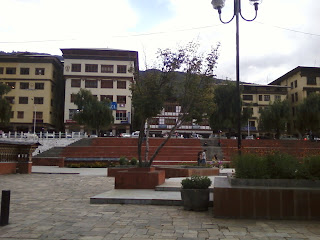 |
| The Village: Plot 4715 |
We live on an un-named street in a neighborhood in Gaborone called "The Village." Gaborone is a Capital City of about 350,000 people and is the largest City in Botswana. Because the Country and Capital City are very young, this City has expanded rapidly and chaotically from the Center, and different portions of the City are known as "Extensions", "Blocks", or "Phases." The Village is located near the University of Botswana in the southeastern portion of the City, and is heavily influenced by the University. We live in University Housing in a row of adjoining apartments. Our nearest neighbors are from Nigeria, Ethiopia, Uganda, and Bulgaria. We think this is one of the best parts of Gaborone to live in: other neighborhoods are composed of huge mansions surrounded by electric fencing and still others are comprised of very small cinder block homes with outhouses.
 |
| Cow Passing Through the Village |
The apartments are painted lime green and each has a separate front and back dirt "yard" surrounded by fences. The front yards are mostly for parking and have padlocked gates. Our backyard has some nice trees in it that attract a wide variety of birds, and a patio with a table and chairs where we often eat breakfast. Once or twice a week a group of women dressed in green jumpsuits sweep the street of all vegetative debris. Further down the road, there have recently been crews of older women and young men and children clearing vegetation with machetes, handsaws and pickaxes. They are also clearing the deep drainage ditches that carry water, sediment and debris during torrential rainstorms. Herds of goats and cattle move through the village from time to time, leaving their organic land mines for pedestrians and weaving through traffic at their will.
Although there is very little public transportation, there are few sidewalks or pedestrian facilities anywhere in Botswana, and for this reason, many people walk down our somewhat quiet and less perilous street, as opposed to choosing one of the busy arterials that parallel our street. When most folks pass each other, they will smile and say "Dumela Rrra or Dumela Mmma" for "Hello Sir or Madam." There are scattered dusty or muddy empty lots in our neighborhood that become the sites of seemingly impromtu driving schools and car washes, and people often have truckloads of produce for sale here and there. There are large pullout areas for the "combis" (minivans) that transport people throughout the City or to the main bus station downtown. A ride on a combi is inexpensive but sometimes terrifying because the combi drivers weave crazily through traffic. Traffic here travels on the opposite side of the road from that in the US, so being in traffic is always a hair-raising experience for us.
 |
| Thapong Visual Arts Center |
Across the street from our row of apartments is the Thapong Visual Art Center and Gallery, and an adjoining small park which includes the foundations of the first colonial fort. The Art Center grounds and the park are full of beautiful sculptures including huge metal animals that are quite striking. Often, the artists are working just on the other side of the fence. Scattered benches offer a nice spot for birdwatching. Trees in the neighborhood offer a rotating palette of color: purple jacarandas, orange Brazilian flametrees, and yellow trumpets, to name just a few. Although they are beautiful, many of the trees in the City are not native to this continent, and are, thus, of less value to native fauna.
Just two blocks away is a Choppies, a Batswana supermarket chain. This Choppies is usually extremely busy and the tiny parking lot is often a huge traffic jam. Inside the store, pop music is blasting and the shelves are perpetually being stocked so getting around in there is always confusing and chaotic. All along the edges of the parking lot, card tables are set up with people selling candy, single cigarettes, gum and phone cards. Near Choppies there is also a pharmacy, a hair salon, a bakery, an internet cafe, a take-way restaurant, a bar, and a bottle store (liquour store). The National Botanical Gardens is within walking distance, and this is a wonderful place to take a walk, get some fresh air, and watch the dassies scrambling among the rocks, and perhaps the local troop of vervet monkeys will be there too, if they are not raiding our garbage can at the time. There is also a gym within walking distance with a refreshingly cool swimming pool surrounded by palm trees with dangling southern masked weaver nests.
The Ngotwane River "runs" (it is usually dry) along the edge of this neighborhood separating it from the neighboring Tlokweng, which was once a separate village but is now a quickly expanding suburb of Gaborone. All this growth means that roads are being constantly widened, and no provisions are made for business or pedestrian access, so pedestrians must pick their own way through active construction zones in and amongst backhoes and steamrollers and often across ditches or huge mounds of dirt. Considering that most folks wear fancy clothes and shoes all of the time, we don't know how they arrive at their destination looking so dapper!
Our neighborhood is full of all sorts of sounds. At dawn, we hear a variety of birds and the sounds of marching and singing from the nearby Police Academy. When there is a soccer match at the University Stadium, we can hear cheering and vuvuzuelas. The sound of traffic is nearly constant. The sounds of cow- and goat-bells tinkle by from time to time. This time of year (late spring), the afternoon often yields booming thunder and torrential rain. We hope you have enjoyed this brief glimpse of our neighborhood; if you have a question about it, please post it in the comments below!





